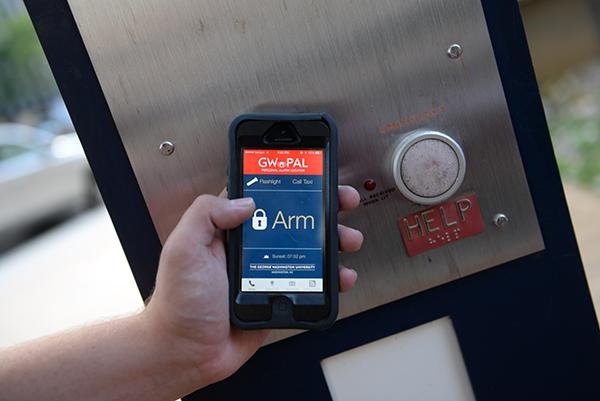Jared Alexander spent a year and a half learning how the University Police Department operates, listening to student calls at the dispatch center and going on a ride along with an officer.
The then-27-year-old alumnus, using knowledge of campus crime and guidance from the Office of Safety and Security, crafted an app that he said is specially tailored to the GW community.
“It was a great experience to step into the shoes of a UPD officer,” Alexander said. “It gave me an opportunity to see how the dispatchers and officers interact with each other and with students.”
His app, called GW PAL, allows students to contact campus police during an emergency without having to dial a phone number, report crime tips and receive updates from GW’s alert system. After launching last week, the app is ready for iPhone users to download through the App Store and for Android users to find on Google Play.
Unlike apps made by companies such as EmergenSee, which has sold its campus safety app with a standard interface to about a dozen colleges, the University’s app connects students directly with UPD and pinpoints a user’s location in relation to GW’s campuses.
The number of alerts from GW’s blue lights across campus has dropped by 26 percent since 2010, and UPD Chief Kevin Hay has said most calls are pranks. Senior Associate Vice President for Safety and Security Darrell Darnell said while the app will not make blue lights “obsolete” on campus, the app will be more useful to students.
“It’s going to be at a party. It’s going to be at your residence hall room. It’s going to be in a classroom. It’s going to be everywhere that you are,” Darnell said. “And quite frankly, crime never takes place in front of a blue phone.”
Darnell first came to the professors in the School of Engineering and Applied Sciences to look for students who could develop an app for a low price. Computer science professor Timothy Wood created the app prototype and then advised Alexander as he took over the project.
After graduating from the computer science master’s program in 2013, Alexander developed the app at a steal for GW, Darnell said, with both Alexander and Wood receiving $5,000 for their work. The University also hired Alexander for a part-time job after he graduated to finish up the app and teach a mobile app development course.
National campus security adviser S. Daniel Carter said safety apps have become more popular on college campuses in the past year, but that it’s too early to tell how they impact campus crime.
“Any tool is going to be only as successful as the instruction and activity in which it is used,” he said. “If people are familiar with the program, it’s going to be a lot more useful than if it’s just there.”
Carter added that college campuses shouldn’t rely on the apps alone to keep students safe.
“Like anything else, it’s a piece of the puzzle. It’s not the solution, but it’s something that can help with information sharing both ways,” he said.
Students who download the GW app can send an alert requesting help from UPD, the fire department or emergency medical services. The app sends the dispatchers the exact location of the student and also passes along his or her cell phone number. Then UPD calls the student to find out more details about the situation.
Students can only send an alert to UPD if they are within the bounds of the Foggy Bottom or Mount Vernon campuses. If they are off campus, the app prompts them to call 911.
Besides their phone numbers, students can choose the information they include in their personal profiles, such as the name of their residence hall or a list of medical issues.
“Jared did a lot of work to make sure that student data was kept safe and that the system would have a high degree of reliability,” Wood said.
The app also features a list of preferred taxi companies that students can call from any location and a flashlight, as well as the expected time of the sunset each day.







